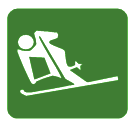|
The Feel-Good Guide to Sports, Travel, Shopping & Entertainment
|
| Main | Sports Events | Holidays & Observances | Pop Culture | Shopping | Travel |
|
Skiing Exercises for Recreational Skiers
The ultimate body for an expert skier is powerful, from strong ankles to strong shoulders, and every finely-tuned muscle in between. Remember the last time you watched someone effortlessly weave through a mogul field and wondered, "How does he do that?" It's partly due to practice, and partly to the body awareness and balance that strength training provides. The expert skier, who is physically strong, instinctively cues every part of his or her body. A fit body is like a well-tuned sports car. It handles effortlessly, acting on subtle intuitions. Skiing requires a number of athletic abilities including technical, physical, and mental skills. This article is all about the physical requirements of expert skiing. Future articles will deal with the technical aspects of all-terrain skiing, as well as establishing the right mind set. But first, to ski strong you need to be strong. Why do ski exercises?
If you think skiing exercises are just for serious skiers, think again. Strong muscles improve every skier's performance, whether he or she is a beginner, intermediate, advanced, or expert skier. For those who feel they've reached a plateau in their skiing ability, ski exercises may provide the boost you need to reach the next level. Few sports are as physically demanding as downhill skiing, especially skiing on moguls, in trees, and down steeps. Yet, many skiers hit the slopes after little or no training in the preseason. They pay for it with sore muscles, but that's only the beginning. In light of the above, this article focuses on building the muscle groups around the joints that skiing taxes the most, including the knees, hips, and ankles. For the knee and ankle joints, we'll be dealing with the upper leg muscles, including the quads and hamstrings, as well as the lower leg muscles, most noticeably the calves and Achilles tendons. For the hip joints, we'll be concerned with the core, namely, the hip flexors, glutes, abdominals, groin, and lower back muscles. Doing the downhill skiing exercises on a regular basis will make your skiing a lot easier, as well as take your skill set to the next level, because you will:
When should you do ski exercises? Exercising in the Preseason
Exercising during the Season Yes, definitely. After the season starts you can catch up and get in sync by doing the exercises during the week when you're not out skiing. If you ski on Saturday and/or Sunday, do the skiing exercises on Tuesdays and Thursdays. By exercising throughout the season, as well as skiing, you'll accelerate the strength building process, and your performance will show a marked improvement. Exercising in the Postseason In addition, by participating in a ski-related exercise program from June to September, you'll be able to ramp up much more quickly in the fall. The summer is also a good time to improve your cardiovascular endurance. The Five Essentials of Ski-Specific Exercising Flexibility: Your range of motion or mobility is of prime importance. Stretching to maintain muscle elasticity, which decreases with age, is vital for skiing. Cardiovascular Endurance: Aerobic capacity is very important to skiers so they have the stamina to ski in the expert zones, and the endurance to ski all day long. If you wish to improve your cardiovascular fitness, try one of the following activities on three nonconsecutive days per week. Perhaps it would be best to do your cardiovascular routine on Mondays, Wednesdays, and Fridays, and your strength, balance, and power exercises on Tuesdays and Thursdays.
With this in mind, target the following ski exercises and muscle groups: Essential exercises for the legs - quadriceps, hamstrings, hips, calves, and ankles Stability and Balance: Why should you care about balance? Well, for starters, it's the basic skill needed in practically every sport. Changing your center of gravity to match your moves is the key to efficiency in sport. Good balance can help you keep your form when you encounter changing terrain and snow conditions. The result is better skiing and fewer spills. Slight deviations in terrain often require subtle adjustments in your balance to avoid injury. To enhance your stability and balance, target the following muscle groups: Essential exercises for the center – abdominals, hip flexors, glutei, and lower back Before you Start About the Author... Jim Safianuk is a certified ski instructor and writer of the downhill skiing lessons in the course Skills of the Expert Skier.
|
 If
you exercise often, you'll begin to build your strength and enhance your endurance in the muscle groups used in downhill skiing. You'll be preparing yourself for the rigors of skiing in the expert zones where both staying power and explosive power are of the utmost importance. First, we'll get into the why and when you need to exercise, before moving onto the five essential elements of ski-specific exercising.
If
you exercise often, you'll begin to build your strength and enhance your endurance in the muscle groups used in downhill skiing. You'll be preparing yourself for the rigors of skiing in the expert zones where both staying power and explosive power are of the utmost importance. First, we'll get into the why and when you need to exercise, before moving onto the five essential elements of ski-specific exercising.

